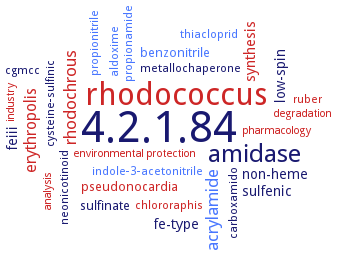4.2.1.84: nitrile hydratase
This is an abbreviated version!
For detailed information about nitrile hydratase, go to the full flat file.

Word Map on EC 4.2.1.84 
-
4.2.1.84
-
rhodococcus
-
amidase
-
acrylamide
-
rhodochrous
-
erythropolis
-
synthesis
-
feiii
-
low-spin
-
fe-type
-
non-heme
-
sulfenic
-
benzonitrile
-
pseudonocardia
-
sulfinate
-
propionamide
-
cysteine-sulfinic
-
neonicotinoid
-
ruber
-
propionitrile
-
cgmcc
-
thiacloprid
-
carboxamido
-
aldoxime
-
indole-3-acetonitrile
-
chlororaphis
-
metallochaperone
-
industry
-
pharmacology
-
degradation
-
environmental protection
-
analysis
- 4.2.1.84
- rhodococcus
- amidase
- acrylamide
- rhodochrous
- erythropolis
- synthesis
-
feiii
-
low-spin
-
fe-type
-
non-heme
-
sulfenic
- benzonitrile
- pseudonocardia
-
sulfinate
- propionamide
-
cysteine-sulfinic
-
neonicotinoid
- ruber
- propionitrile
-
cgmcc
- thiacloprid
-
carboxamido
- aldoxime
- indole-3-acetonitrile
- chlororaphis
-
metallochaperone
- industry
- pharmacology
- degradation
- environmental protection
- analysis
Reaction
Synonyms
3-cyanopyridine hydratase, acrylonitrile hydratase, aliphatic nitrile hydratase, ANHase, Co-type NHase, Co-type nitrile hydratase, cobalt-containing nitrile hydratase, CoIII-NHase, CtNHase, Fe-NHase, H-NHase, H-nitrilase, high-molecular mass nitrile hydratase, high-molecular weight nitrile hydratase, hydratase, nitrile, iron-type nitrile hydratase, L-Nhase, L-nitrilase, low-molecular mass nitrile hydratase, low-molecular weight nitrile hydratase, MbNHase, NHase, NHaseK, NI1 NHase, NilCo, NilFe, nitrilase, nitrile hydratase, NthAB, PaNit, ppNHase, ReNHase, TNHase, toyocamycin nitrile hydratase
ECTree
Advanced search results
General Stability
General Stability on EC 4.2.1.84 - nitrile hydratase
Please wait a moment until all data is loaded. This message will disappear when all data is loaded.
Escherichia coli chaperones GroEL-ES work well in Rhodococcus and simultaneously possess protein-folding assistance functions and the ability to stabilize and reactivate the native nitrile hydratase
-
immobilization and stabilization of a nitrile hydratase in the form of a cross-linked enzyme aggregate using ammonium sulfate as an aggregation agent followed by cross-linking with glutaraldehyde, method development and evaluation, overview. The stability of aggregated and immobilized enzyme is increased compared to enzyme in cell extract or whole cells
-
KH2PO4-NaOH and Tris-HCl buffer are tested at 28°C and pH 7.5. 20% NHase activity is lost after 18 h and is further decreasing. 73.5 h later, NHase activity in Tris-HCl is unchanged while in KH2PO4-NaOH abrupt decrease is observed.
-
loss of activity caused by storage at 0°C can be restored by irradiation with light of 370 nm
-
nitrile hydratase cross-linked enzyme aggregates are sensitive to water-immiscible organic solvents as well as to aldehydes and hydrogen cyanide, but are remarkably stable and show useful activity in acidic aqueous environments of pH 4-5
-
organic acids stabilize, stable for more than 1 month in 0.1 M HEPES/KOH, pH 7.2, with 44 mM n-butyric acid, n-valeric acid, isovaleric acid, isobutyric acid or n-caproic acid
-
purified mutant NHases are stored in the dark without n-butyric acid, before use, NHases are activated by light irradiation.
-
residual activity levels after heat shock and acrylamide immersion increase by 2.9fold and 1.1fold, respectively in nitrile hydratase-chaperone GroEL2 chimera compared with the single nitrile hydratase control
-
the enzyme becomes more unstable as it becomes purer. Isovalerate, 30 mM, and caprylate stabilize effectively
-
the partially purified enzyme is stable in the presence of organic acids at higher temperatures
-
unstable when diluted, but completely stabilized with low-molecular organic acids such as n-butyric acid, n-valeric acid, propionic acid and acetic acid
-


 results (
results ( results (
results ( top
top





